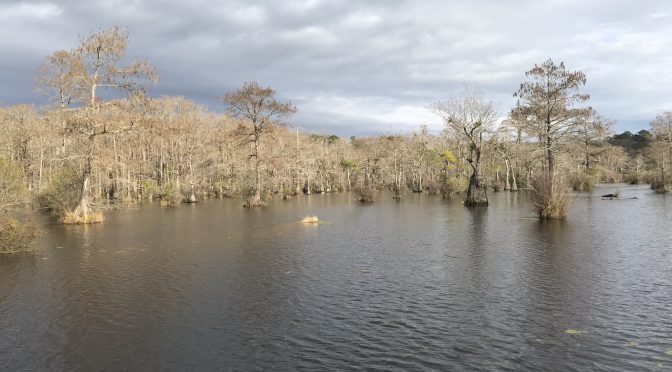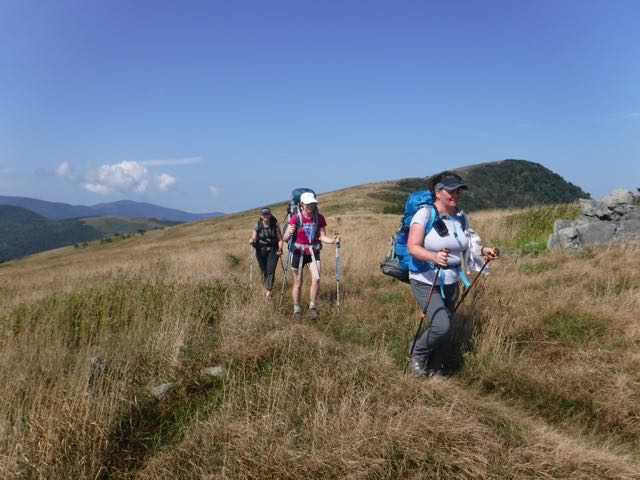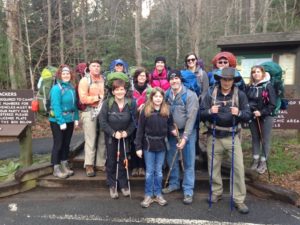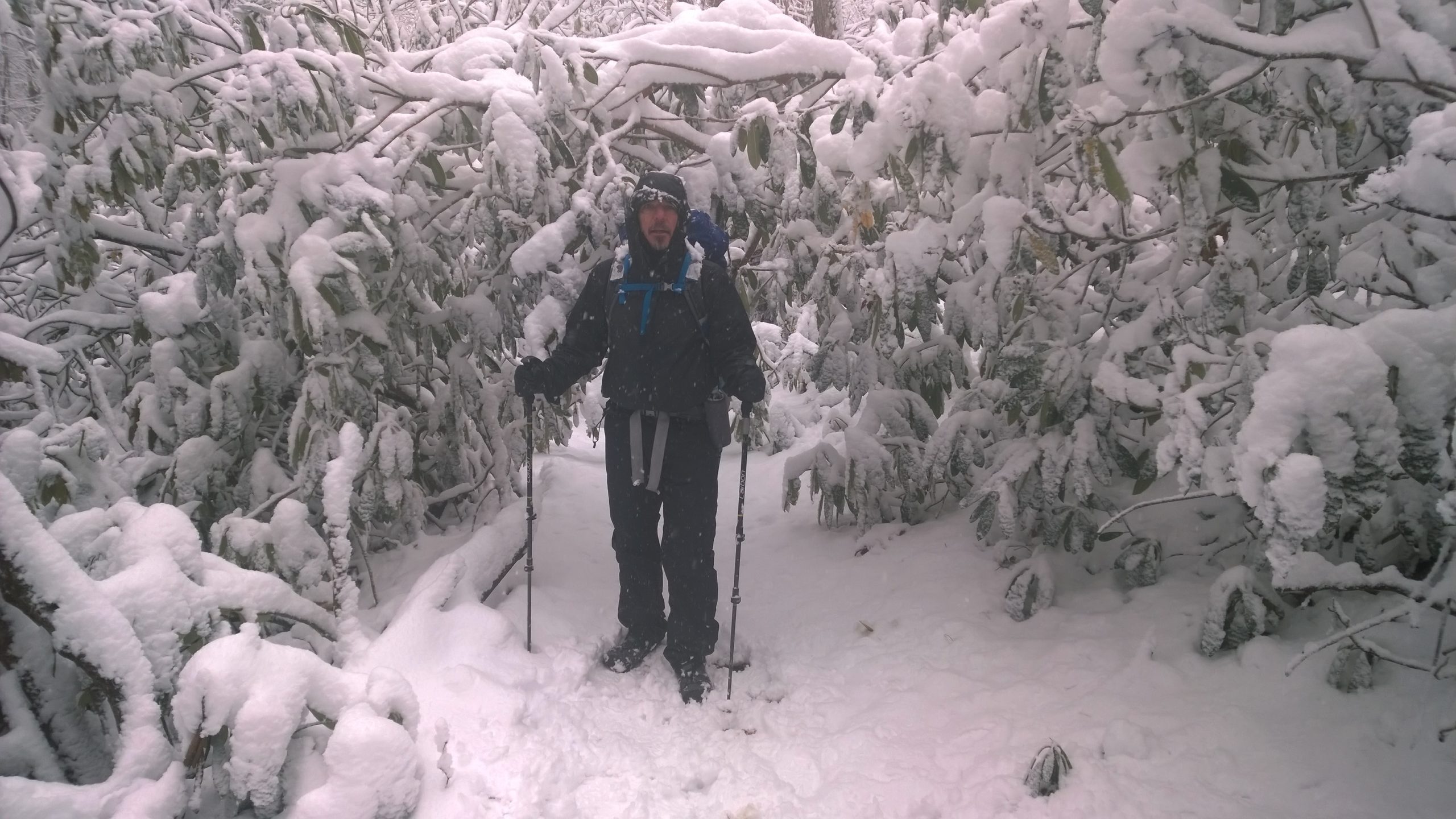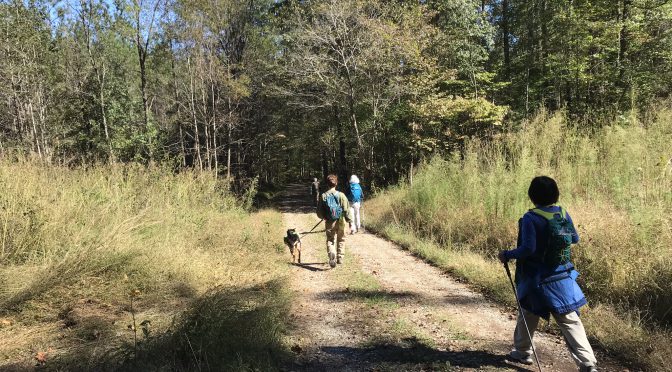Our plan for the Martin Luther King Jr. weekend was to take a group of backpackers to the mountains for three days on the AT between Max Patch and Hot Springs. The goal was to give three-season backpackers a taste of winter. But when the forecast suddenly shifted and called for temperatures near zero and more than just an inch or two of snow, it was time to rethink our plan. Since that wasn’t what this group had signed up for or was properly geared up to do, we postponed the trip.
Category Archives: Backpacking
Layer up and Get OuT
On Saturday morning’s GetHiking! hike at Umstead State Park, half the number of hikers who signed up showed up. No mystery there: it was cold.
What is a mystery is why so many hikers let a little thing like freezing temperatures keep them off the trail. As we may have mentioned (just last week, in fact), we love a winter hike: among other things, there are fewer people, fewer bugs, and it’s blissfully quiet. Yet too many people miss out because they don’t know how to dress. Let’s solve that problem here and now.
GetBackpacking! with us in 2019
Ready to up your backpacking game in 2019? Or get a backpacking game going, period? We’re ready to help!
First, if you’re curious about backpacking but don’t have any experience, we have two courses designed to get you started.
- GetBackpacking! Intro to Backpacking. More than 200 backpackers have come through this comprehensive intro course since it launched in 2013. We start with a two-hour gear session, going over the gear you’ll need, the gear options available, and how to get that gear into your pack. Next we have a five-hour, in-the-field training session in which we hike two miles in full pack, scout campsites, set up camp, cook a meal, break camp and hike out. Finally, we take a weekend trip to South Mountains State Park. Loaner gear available.
- GetBackpacking! Overnight Sampler. Intrigued by backpacking but not ready to commit to our Intro class? This overnight session gives you a taste of hiking with a full pack and of spending the night in the woods. Backpacking gear and food provided.
Now, let’s get into our trips! Unless otherwise indicated, our backpack trips accommodate folks with a range of experience, from recent graduates of Intro to Backpacking through experienced backpackers. Newer backpackers learn from experienced backpackers. And, since we do all the planning, experienced backpackers will be able to get in more than a trip or two a year. Here’s where we’re headed the first half of 2019:
- Appalachian Trail: Max Patch to Hot Springs, January 19-21. Get a taste of winter camping on one of the more winter-friendly 20-mile stretches of the AT in the state. Trip includes shuttle, and for folks with minimal winter camping experience, we will have a pre-hike winter-preparedness training session.
- Croatan National Forest: Neusiok Trail, February 8-10. If it’s too cold for you to backpack the mountains in February, you’ll love the milder weather on this trip in the coastal Croatan. This 20-miler isn’t entirely flat: the northern six miles has some mildly rolling terrain, including a patch or two hinting of the mountains. The Neusiok Trail in winter is our most popular backpack trip.
- Uwharrie National Forest: Dutchman’s Creek Loop, March 30-31. This is a good opportunity for warm-weather backpackers to shake off the winter cobwebs and get ready for the backpacking season. We’ll hike in 5.5 miles on Saturday, camp, then complete the loop Sunday with a 6.5-mile hike out. This trip is for women only.
- Appalachian Trail: Carvers Gap to US 19E, April 5-7. Mile-for-mile, trail doesn’t get much more scenic than this 21-mile run that starts with three balds in the first couple miles, encounters two more about 8 miles in, and throws in additional great views along the way. We’ll be on the cusp of the spring wildflower bloom as well.
- Intro to Linville Gorge, May 17-19. Full immersion into Linville Gorge can be overwhelming for the first-time backpacker: the trails are steep, rocky, rugged. On top of that, the gorge has a way of generating its own weather. In this introduction, we establish base camp on the east rim, atop Shortoff Mountain, then don daypacks to drop into the gorge itself.
- Going Solo in Wilson Creek, May 31-June 2. In this weekend class, we hike in and spend the first night together. The second night, backpackers spread over a mile-long stretch of trail for their first overnight solo (with the trip leader not far away).
Make 2019 your year of backpacking.
Happy trails,
Joe
For more info
Classes
To hike, or not to hike
Thus began the evaluation process we go through when deciding whether the weather will affect a planned hike. It’s a process that goes something like this:
=&0=& I started following the forecast for Tuesday night a week ago. There was a suggestion of weekend snow at the time, though, as is often the case with snow, the amounts were vague, as were the locations to be affected. Usually for a day hike, I don’t start checking the forecast until two or three days out; for overnight trips, I begin checking about a week in advance to get a general idea of what might be coming. Three days out I will take a second, more serious look. If it appears weather could be an issue, I’ll …
=&1=&=&2=&The Tuesday Night Hike roster is a mix of experienced and less-so hikers. A decision about whether to hike in this case is complicated by the fact that the hike is at night, and not all the hikers — even the experienced ones — are as comfortable hiking under the lights. In general, if it’s an entry level trip I’ll judge the weather with a more critical eye for two reasons: 1) these are beginners, just starting out and might not have the gear to deal with rain, with cold or less- than-ideal conditions; 2) We want beginners to have a good first experience. You do an overnight trip with daytime temperatures around 70, overnight lows around 50 and clear skies, and who isn’t going to want to come back? On the other hand, if it’s an experienced group, we’re more likely to proceed if the weather isn’t optimal. About the only two things that will scuttle a trip for experienced folks is extreme cold (15 F or less) and a high likelihood of electrical storms.
=&1=&=&4=& Three days, because if the weather looks convincingly grim, this is when you need to begin alerting people that the hike may not happen, less so for a shorter day hike, but certainly for an overnight trip that people have to make plans in advance for, like canceling a pet sitter. I usually don’t make a final call this far out, but will let people know that the trip is in jeopardy and when we will let them know if it’s still on. In the case of our Tuesday Night Hike, on Saturday, milk, bread and eggs were flying off the shelf as the forecasters were growing more certain of snow, and lots of it.
=&1=&=&6=& On Monday, it was less the forecast for Tuesday night and more the reality of the day. I wasn’t sure how much snow had fallen at the trailhead, but it was likely between 8 and 13 inches. The forecast called for some warming Monday and afternoon and Tuesday, but refreezing overnight: this snow wasn’t going anywhere soon. And what did melt was likely to turn to ice once the sun set. Usually, we’ll wait until the day before, at the earliest, to call a hike. Much can change in a forecast, which is why we sometimes will wait up until three hours before a hike to make a final call (in such cases, that’s often because we’re waiting to see what the weather radar, the final arbiter, indicates). A day out is when we start to consider our four cancellation factors:
=&1=&=&8=&: =&9=&. We usually don’t cancel a hike because of extreme cold, but we will let people who have signed up know what kind of gear they will need to survive — yes, survive — a very cold hike.
=&1=&=&11=&. I personally love hiking in the rain, even a sustained rain. But then, I’ve got the gear for it. A forecast that looks reliably wet warrants an email to those who’ve signed up as to the rain gear they will need if they don’t want to wind up damp and dour.
=&1=&=&13=&. This is a big one. If just getting to the trailhead could be treacherous, we’ll cancel a hike.
=&1=&=&15=&
Trail etiquette Part II: Now, about your dog …
“Also, please leash your pets,” Jennifer commented on our Facebook page. “I know they love to run, but some of us have been attacked and this situation makes me a nervous wreck.”
To wit, six additional rules of etiquette pertaining to our four-legged hiking companions.
- Leash your dog. A good place to start — thanks, Jennifer. Most places where we hike — state parks, municipal parks, national parks, nature preserves — require that your dog be leashed, and many require that they be on a six-foot leash, not a 16-foot retractable tether that can wreak havoc for unsuspecting hikers, cyclists, equestrians. The reasons for leashing are many. At the top of the list is that some hikers aren’t comfortable with dogs, especially ones that come bounding up to them in the wild, friendly though they may be. There’s also the matter of protecting the dog from—squirrel! Fido’s primal olfactory instincts kick in and he may never be seen again.
- Keep the other end of the leash attached to you. Yes, it does need saying. At lease twice we’ve had loopholers let their dogs run free, the leash dragging behind them. We’ve since included this seemingly obvious aspect of the leash rule to our prehike instructions.
- Pick up your pup’s poop. Everywhere you hike, this is the rule. But more than being a rule, it’s just common courtesy to your fellow hikers. Hopefully, we don’t need to elaborate.
- … And take the poop bag with you. Well, yes, actually, we do need to elaborate: After you have bagged said poop, take it with you, do not leave it packaged by the side of the trail. We’ve heard more than one hiker say, “I’ll pick it up on my way out.” If this is the explanation behind every trailside receptacle of refuse we spot, then somewhere deep in the woods there are hundreds of hikers and their dogs wandering in search of the “way out.”
- Seek permission before petting. I know: every dog looks like it wants to be petted. Even so, ask permission before taking a knee and diving into a rousing round of, “Who’s-a-good-good-good dog?” with a dog you don’t know — and, perhaps more importantly, doesn’t know you.
- Know your dog. Not all dogs like other dogs. Or people. If your dog has an iffy history with other critters, avoid heavily trafficked trails at busy times.
One more etiquette addendum. Sharon wrote on our Facebook page to “tell mountain bikers that the rules for them are not suspended on Saturdays (or ever).” Her suggestion was based on a recent visit to DuPont State Forest, home to miles of multiuse trail.
“I encountered dozens and dozens of enthusiastic dirt warriors speeding in both directions and very few of them paused. They were eager to tell us how many more of them were behind us, however.”
That lead to a brief back-and-forth about multiuse trails, about how they tend not to work in places where recreationalists of different mobile persuasions aren’t used to coexisting. The 10,000-acre DuPont is an oasis of multiuse in a sea of mostly segregated trails in the nearby Pisgah National Forest. Thus, a couple etiquette suggestions especially pertinent to multiuse trails:
- Hikers, stay to the right. Hikers should skew to the right of a multiuse trail. In part, that’s because it makes the next bit of etiquette advice easier …
- On your left. We touched on this passing admonition last week for hikers and runners; it’s especially important when dealing with hikers and bikers. A biker coming up on a hiker should slow and issue the advisory no later than 30 to 50 feet before encountering the hiker. The hiker already favoring the right side of the trail need only take a quick additional step to the right to avoid conflict. A quick “thanks,” a quick “you’re welcome” and we’re good.
- Additional cyclists? Sharon noted in her comment that the mountain bikers “were eager to tell us how many more of them were behind us.” That’s a courtesy, so the hiker knows that it would be good to stay on the right side of the trail until the announced number of cyclists have passed.
Observing a few simple, common sense rules of trail etiquette will come in especially handy over the Thanksgiving holiday weekend, when the trails will be packed. Be considerate, and have a great hike!
Happy trails,
Joe
Speaking of a busy Thanksgiving weekend
In conjunction with our partners at Great Outdoor Provision Co., our GetHiking! chapters in North Carolina and Virginia will be sponsoring six hikes this Friday, known in retail circles as Black Friday, known at Great Outdoor Provision Co. as Chill Friday. Here’s a list of those six hikes. For more information on each, go here.
=&9=& Brumley Forest Nature Preserve, Hillsborough. 9 a.m.
=&10=&=&11=&
